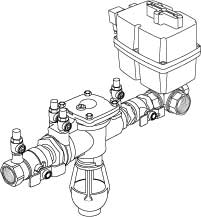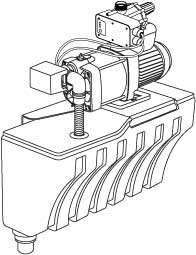 General Information
General InformationGreen Roofs
Rainwater Harvesting
Systems
Pre-Filtration
Storage
Pumping
Treatment
Measurement + Control
Backup Integration
Design
Documents
Ponds and Wetlands
Energy-Efficient Building
Waterproofing

BACKUP INTEGRATION
If rainwater is to serve as the principal water supply for a building, or if it is the primary exterior water supply, then provision must be made to automatically switch to a backup water supply when there is insufficient rainwater to meet demand. We offer three different solutions that effectively isolate the two water supplies to prevent cross-contamination.

mechanical
valve

solenoid
valve
CISTERN BACKUP: The least expensive backup method is cistern backup. When the water level in the rainwater tank reaches a pre-set low level, a valve opens and water from the backup source is added directly to the rainwater tank. To prevent cross-contamination, the outlet of the backup water pipe in the tank must be several inches above the highest possible water level of the rainwater tank, or the backup water can flow through a funnel device that provides a similar air gap. Unfortunately, cistern backup creates the undesirable situation where potable-quality backup water is mixed with sediment-laden water at the tank bottom, producing a degraded mixture as the water supply.
The simplest cistern backup system utilizes a special mechanical valve with a weighted float at the end of a long cord. When the water level in the tank reaches the float, the valve opens and adds several inches of water. We offer two versions: a 1/2” low-flow valve that delivers 2 gpm @ 20 psi and a 1” high-flow valve that delivers 50 gpm @ 30 psi.
More sophisticated cistern backup systems utilize a solenoid valve controlled by a low-voltage float switch or an electronic control device. Our commercial-grade solenoid valves offer the highest possible reliability for this type of backup. Unlike typical irrigation valves, they feature high-efficiency solenoids, stainless-steel actuators, and brass shock cones. If there is a power failure, they automatically shut off water flow. We stock 1” and 1.5” sizes.
DIRECT BACKUP: The most reliable backup method is direct backup in which both the backup source and rainwater supply directly connect to the plumbing system through a motorized three-port valve. When there is sufficient water in the rainwater tank, the valve connects the rainwater supply to the plumbing system. When the water in the rainwater tank reaches a pre-set low level, the valve connects the backup water supply to the plumbing system. A reduced pressure backflow preventer is installed between the backup supply and the valve to eliminate the possibility of cross-contamination.

direct backup with 3-port valve
We offer a wide range of industrial-quality three-port ball valves that are ideal for direct backup systems. Unlike most solenoid valves, they do not leak under back pressure and have low pressure drop. The valves are directly coupled to a weatherproof low-wattage 24vac electric rotary operator. When power is applied, the ball rotates 90° in one direction; when power is reversed the ball rotates 90° in the other direction. For interior water supply systems we offer an optional internal battery that automatically connnects the valve to a public water supply backup in the event of a power failure to assure pressurized water will always be available for toilet flushing and other critical water uses. We can supply 1”, 1-1/4”, 1-1/2”, and 2” valve assemblies in brass or PVC.
FLOAT-TANK BACKUP: The safest backup method is float-tank backup, named for a small wall-mounted tank that contains a float valve. When there is sufficient rainwater, an external pump draws water from the rainwater tank by way of a three-port valve and delivers the water to the plumbing system. When the rainwater tank is low, the three-port valve switches so that the pump draws water form the wall-mounted tank. As the water level in this small tank drops, a float valve inside the tank opens and refills the tank. The tank has a primary overflow that is directly plumbed through a trap, as well as an upper emergency overflow that simply dumps water on the floor if the primary overflow ever gets clogged. This assures there will always be an air gap below the float valve, providing absolute protection from cross-contamination.

float tank system
Our standard float tank system consists of a fully-automatic external pump mounted on top of a small float tank. The pump sucks backup water from the float tank through a 120vac multi-port valve. A float switch running from the valve to the rainwater tank switches the valve between the two water supplies based on the rainwater level. When combined with a pre-filter and storage tank, this assembly serves as an all-in-one rainwater pumping and backup system suitable for operating a residential-scale rainwater system with peak flow rates up to 15 GPM.
Our commercial float tank system is a larger, custom-assembled system capable of peak flow rates up to 30 GPM. Typically we install a mechanical float valve inside the tank, mount a 24vac three-port valve to the bottom of the tank, and attach an external pump to the the three port valve, matching each component to the flow requirements of the project. For commercial float tank backup systems, the three-port valve is controlled by our Rainwater System Controller or Wireless Ultrasonic Control System (see Measurement + Control).

commercial float tank